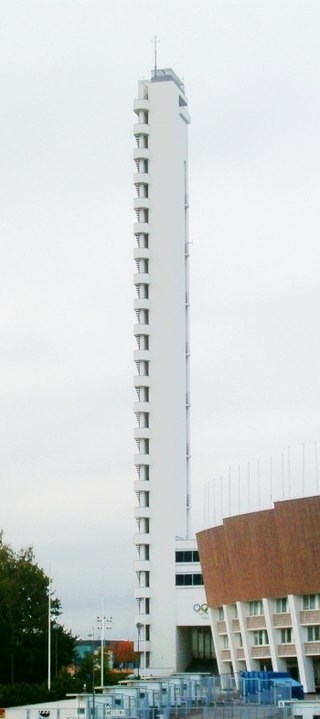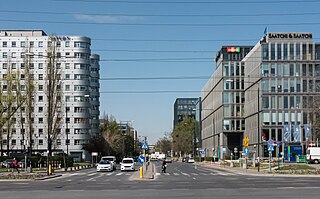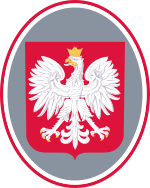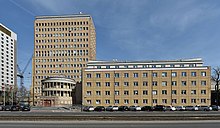
Warsaw, officially the Capital City of Warsaw, is the capital and largest city of Poland. The metropolis stands on the River Vistula in east-central Poland. Its population is officially estimated at 1.86 million residents within a greater metropolitan area of 3.27 million residents, which makes Warsaw the 7th most-populous city in the European Union. The city area measures 517 km2 (200 sq mi) and comprises 18 districts, while the metropolitan area covers 6,100 km2 (2,355 sq mi). Warsaw is an alpha global city, a major cultural, political and economic hub, and the country's seat of government. It is also capital of the Masovian Voivodeship.

In architecture, functionalism is the principle that buildings should be designed based solely on their purpose and function. An international functionalist architecture movement emerged in the wake of World War I, as part of the wave of Modernism. Its ideas were largely inspired by a desire to build a new and better world for the people, as broadly and strongly expressed by the social and political movements of Europe after the extremely devastating world war. In this respect, functionalist architecture is often linked with the ideas of socialism and modern humanism.

Stefan Władysław Bryła was a Polish construction engineer and welding pioneer. He designed and built the first welded road bridge in the world.
The history of rail transport in Poland dates back to the first half of the 19th century when railways were built under Prussian, Russian, and Austrian rule. Of course, "divided Poland" in the 19th century was the territory of the former Polish–Lithuanian Commonwealth and not that one of today's Republic of Poland. After Polish independence was declared on 11 November 1918, the independent Polish state administered its own railways until control was surrendered to German and Soviet occupiers during World War II.

The autostrada A2 in Poland, officially named the Motorway of Freedom, is a motorway which runs from the Polish-German border, through Poznań and Łódź to Warsaw and, in the future, to the Polish-Belarusian border. It is a part of European route E30.

The Złote Tarasy, also known by its anglicized name Golden Terraces, is a commercial, office, and entertainment complex in the city centre of Warsaw, Poland. It is located at 59 Złota Street, between Jana Pawła II and Emilii Plater. It was opened on 7 February 2007. The complex consists of Złote Tarasy shopping centre, Lumen office building, and the Skylight office skyscraper building, which is among top 30 tallest buildings in the city. The complex is owned by Unibail-Rodamco-Westfield.

Plac Bankowy is one of Warsaw's principal squares. Located in the downtown district, adjacent to the Saxon Garden and Warsaw Arsenal, it is also a principal public-transport hub, with bus and streetcar stops and a Warsaw Metro station.

The Potocki Palace is a large baroque palace in Warsaw, located at Krakowskie Przedmieście 15, directly opposite the Presidential Palace. It was originally built for the Denhoff family and in the late 18th century became the property of the Potocki family.

Służewiec is a neighbourhood, and an area of the City Information System, in the city of Warsaw, Poland, located within the district of Mokotów. Most of the neighbourhood consists of office buildings, which form one of the biggest complexes of office buildings in Poland, and one of the most important office centres in the city. It contains many headquarters of branches of many domestic and multinational corporations. A small portion of the neighbourhood also forms a residential area with apartment buildings.

POLIN Museum of the History of Polish Jews is a museum on the site of the former Warsaw Ghetto. The Hebrew word Polin in the museum's English name means either "Poland" or "rest here" and relates to a legend about the arrival of the first Jews to Poland. Construction of the museum in designated land in Muranów, Warsaw's prewar Jewish quarter, began in 2009, following an international architectural competition won by Finnish architects Rainer Mahlamäki and Ilmari Lahdelma.

The Prudential House, officially known now as the Hotel Warszawa, is a historic skyscraper hotel in Warsaw, Poland, located on Warsaw Insurgents Square along Świętokrzyska Street. Built between 1931 and 1933 in the Art Deco style, it served as a base for the British Prudential Insurance Company. It was the tallest building in the interwar Poland.

The Temple of Divine Providence and Pantheon of Great Poles (in Polish, Panteon Wielkich Polaków, in southern Warsaw's Wilanów district, is a principal Roman Catholic church in Poland. The backstory of its construction began in the 18th century. The Temple is conceived as a national and religious symbol for Poland. The complex comprises the Church of Divine Providence, the Museum of John Paul II and Primate Wyszyński, and the Pantheon of Great Poles.

Nowy Świat-Uniwersytet is a station on the central part of Line M2 of the Warsaw Metro.

Muzeum Sztuki Nowoczesnej w Warszawie is a museum in Warsaw, Poland. It was established in 2005.

The Ministry of Infrastructure is a ministry within government of Poland currently responsible for transport, inland navigation, water and maritime resources and exploatation. Incumbent Minister of Infrastructure is Dariusz Klimczak since 13 December 2023. Ministry headquarters are located at 4/6 Chałubińskiego Street in Warsaw.

Ministry of Transport, Construction and Maritime Economy was formed on 21 November 2011, from transformation of Ministry of Infrastructure.

The General Stefan "Grot" Rowecki Bridge is a bridge over the Vistula River in Warsaw. It was built from 1977 to 1981 as part of the Trasa Toruńska major thoroughfare by Przedsiębiorstwo Robót Kolejowych No. 15 and Mostostal. Today, it is part of the S8 expressway, forming the northern bypass of Warsaw.

Ministry of Infrastructure and Construction was the office of government in Poland responsible for construction and infrastructure. Andrzej Adamczyk was the only Minister of Infrastructure and Construction. It was created in late 2015 from the split of the Ministry of Infrastructure and Development, in 2018 became Ministry of Infrastructure.

Varso or Varso Place is a neomodern office complex in Warsaw, Poland. It was designed by Foster + Partners and developed by HB Reavis. The complex features three buildings; the main one, Varso Tower, is the tallest building in Poland, the tallest building in the European Union, and the sixth-tallest building in Europe at 310 m (1,020 ft) in height. It was topped out in February 2021 and completed in September 2022, with the opening of the observation deck planned for 2024.




















